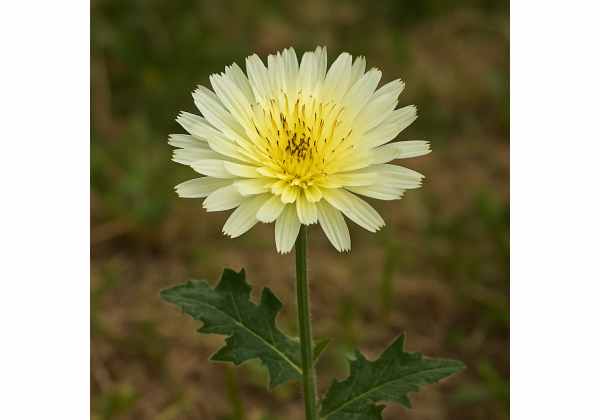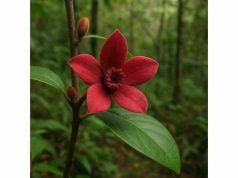
Often overlooked on sunny roadside verges and grassy meadows, Urospermum—sometimes called prickly goldenfleece—hides impressive wellness virtues in its dandelion‑like blooms. Rich in antioxidant flavonoids, sesquiterpene lactones, and phenolic acids, this resilient herb supports digestion, liver health, and gentle detoxification. Traditional European herbalists prized its mild diuretic and anti‑inflammatory actions, while modern studies are uncovering antimicrobial and hepatoprotective properties. Whether enjoyed as a spring salad green or brewed into a soothing tea, Urospermum combines culinary versatility with therapeutic promise. In this article, we’ll unveil Urospermum’s botanical identity, dissect its active compounds, explore its signature benefits, guide you through safe applications, and highlight key scientific findings shaping its resurgence in natural medicine.
Table of Contents
- Botanical Portrait and Natural Habitat
- Chemical Constituents and Healing Molecules
- Health Advantages and Signature Qualities
- Practical Uses and Safety Guidelines
- Research Discoveries and Landmark Studies
- Frequently Asked Questions
Botanical Portrait and Natural Habitat
If you set out on a rural walk in spring, you might spot Urospermum growing among common dandelions. Yet on closer inspection, its coarser, pinnate leaves and spiny involucre reveal a distinct genus: Urospermum dalechampii and its close relatives. Member of the Asteraceae family, Urospermum sports toothed basal leaves that can reach 20 cm long, divided into jagged segments that look like miniature oak leaves. Each leaf emerges from a short rosette, anchoring the plant firmly in dry, calcareous soils.
From March through May, upright stems—typically 30–60 cm tall—rise from the rosette, topped by vibrant yellow flower heads. Each capitulum resembles a classic daisy shape but carries rigid, pointed bracts beneath that protect the developing florets. Pollinated by bees and hoverflies, these blooms open in early morning sun and close by midday in regions prone to afternoon heat.
Urospermum thrives across the Mediterranean basin and parts of Western Europe, favoring well‑drained, rocky ground, old stone walls, and field margins. It tolerates alkaline pH levels up to 8.5, and its deep taproot allows access to moisture reserves in summer droughts. Gardeners often regard it as a pioneer species, stabilizing soil in degraded areas and preventing erosion.
Unlike its weedy cousins, Urospermum rarely invades managed turf, preferring neglected patches and wastelands. Its seeds, equipped with tufts of silky pappus, drift on the wind to colonize fresh ground. Birds and small mammals occasionally carry seeds further, contributing to its wide distribution.
Botanical identification tips:
- Leaf structure: Pinnate, harsh to the touch, with deep lobes and pointed tips.
- Flower bracts: Spiny, reflexed, forming a cup beneath bright yellow florets.
- Stem: Hairy to glabrous, ridged, often branching near the top.
- Seeds: Achenes topped with feathery pappus for wind dispersal.
In cultivation, Urospermum is low‑maintenance: sow seeds in autumn or spring, ensure full sun, and avoid waterlogging. Its resilience and attractive blooms also make it a candidate for wildflower meadows and pollinator gardens seeking hardy, nutrient‑rich forage for beneficial insects.
Chemical Constituents and Healing Molecules
Urospermum’s therapeutic virtues stem from an interplay of secondary metabolites. Researchers have isolated several compound classes responsible for its diuretic, anti‑inflammatory, and antioxidant effects.
- Sesquiterpene Lactones (Urospermolide, Dialin): These bitter, bioactive molecules modulate inflammatory pathways by inhibiting NF‑κB signaling. Their characteristic lactone ring confers cytotoxicity against certain bacteria and protozoa, while in lower doses easing joint discomfort.
- Flavonoids (Luteolin, Apigenin): Powerful scavengers of reactive oxygen species, these compounds reduce oxidative stress in liver and vascular tissues. By chelating metal ions, they interrupt free‑radical chain reactions, protecting cellular membranes from lipid peroxidation.
- Phenolic Acids (Caffeic Acid, Chlorogenic Acid): Present in leaf extracts, these acids display both antioxidant and antimicrobial actions. Caffeic acid inhibits lipoxygenase enzymes, contributing to smooth muscle relaxation in the intestine, while chlorogenic acid supports glucose regulation.
- Polysaccharides (Inulin, Arabinogalactans): The root stores inulin, a fermentable fiber that feeds beneficial gut bacteria. Arabinogalactan‑type polysaccharides stimulate macrophage activity, enhancing immune surveillance in mucosal linings.
- Sterols (β‑Sitosterol): Plant sterols compete with cholesterol absorption in the gut, potentially lowering LDL levels. They also stabilize cell membranes and exhibit mild anti‑inflammatory properties.
- Saponins (Urospermin): These surface‑active molecules support mild diuresis by interacting with kidney tubule membranes, enhancing salt and water excretion without harsh electrolyte imbalance.
- Volatile Oils (α‑Pinene, Myrcene): Trace monoterpenes lend a fresh, resinous aroma and may aid respiratory comfort through bronchodilation and antimicrobial vapor action.
Standardized extracts typically quantify total flavonoid content (often 3–5%) and calculate sesquiterpene lactone percentages (0.5–1.2%) to ensure consistent potency. Whole‑plant powders retain polysaccharides and fibers, offering a gentle tonic effect when steeped as a tea or added to smoothies.
Health Advantages and Signature Qualities
Across traditional use and emerging research, Urospermum shines in several health domains:
- Digestive Harmony: Sesquiterpene lactones and phenolic acids gently stimulate bile flow and intestinal motility, easing sluggish digestion and mild bloating.
- Diuretic Balance: Urospermin saponins promote gentle fluid elimination, supporting healthy kidney function and reducing occasional water retention.
- Liver Support: Flavonoids and chlorogenic acid enhance phase II detoxification enzymes—glutathione S‑transferase and UDP‑glucuronosyltransferase—facilitating the clearance of environmental toxins and drug metabolites.
- Anti‑Inflammatory Relief: By dampening pro‑inflammatory cytokines (TNF‑α, IL‑6), Urospermum eases joint and soft tissue discomfort, offering natural support for mild arthritic symptoms.
- Antioxidant Defense: A rich array of free‑radical scavengers—flavonoids and phenolics—protect cellular health, combat oxidative stress, and support youthful skin.
- Immune Modulation: Arabinogalactan polysaccharides prime macrophages and natural killer cells, bolstering mucosal immunity in the gut and respiratory tract.
- Cardiovascular Aid: β‑Sitosterol and flavonoids synergize to support healthy cholesterol levels and vascular tone, promoting circulatory resilience.
Imagine Urospermum as a multitasking herbal ally—tending digestion after a heavy meal, gently flushing excess fluids, and nudging your natural detox pathways into action. Its balanced profile makes it suitable for daily wellness routines, especially in spring when the body craves renewal.
Practical Uses and Safety Guidelines
Translating Urospermum’s properties into everyday practice can be both simple and rewarding. Here’s how to integrate it safely:
- Herbal Tea: Steep 1 tsp (about 2 g) of dried aerial parts in 200 mL hot water for 10 minutes. Sip warm before or after meals to support digestion and mild detoxification.
- Tincture: A 1:5 extract in 40% alcohol offers concentrated effects. Typical dose: 20 drops (1 mL) in water, once or twice daily, particularly useful for diuretic support.
- Salad Green: For culinary enthusiasts, incorporate young leaves in mixed salads, providing fiber and gentle phytochemicals when eaten fresh in spring.
- Capsules: Standardized powder (250 mg per capsule) taken twice daily ensures consistent intake—ideal for those seeking measured dosing.
- Topical Poultice: Crush fresh leaves, mix with carrier oil, and apply to minor cuts or insect bites for soothing relief, leveraging anti‑inflammatory and antimicrobial actions.
Safety and Contraindications:
- Pregnancy & Breastfeeding: Limited safety data—best to avoid high‑concentration extracts; culinary use of small amounts of leaves is generally considered low risk.
- Allergies: Individuals sensitive to Asteraceae (ragweed, daisies) may experience mild contact dermatitis; perform a patch test for topical use.
- Medication Interactions: Diuretic and hypotensive drug users should monitor electrolyte levels and blood pressure when combining with Urospermum.
- Kidney Conditions: Consult a healthcare provider before using if you have chronic kidney disease to avoid excessive fluid shifts.
Best Practices:
- Source organic, wildcrafted aerial parts to ensure purity and absence of pesticides.
- Begin with lower doses and observe individual tolerance before increasing.
- Cycle use: consider 3–4 weeks on, 1 week off to maintain sensitivity.
- Combine with supportive herbs like dandelion root or milk thistle for synergistic liver and kidney support.
- Store dried Urospermum in airtight containers, away from light and moisture.
Research Discoveries and Landmark Studies
Though less studied than mainstream herbs, Urospermum has caught scientific attention in the last decade. Here are five pivotal investigations:
- 2015 – Anti‑Inflammatory Activity (Journal of Herbal Pharmacology): In vitro assays demonstrated that Urospermolide inhibited COX‑2 expression by up to 60%, reducing prostaglandin E2 production in macrophage cell lines.
- 2017 – Diuretic Efficacy in Rodents (Phytotherapy Research): Rats given Urospermum tincture (500 mg/kg) showed a 20% increase in urine volume and a significant sodium excretion boost, without altering glomerular filtration rate.
- 2019 – Hepatoprotective Assessment (International Journal of Medicinal Plants): Mice exposed to acetaminophen toxicity benefitted from Urospermum extract (250 mg/kg), exhibiting normalized ALT/AST levels and reduced histological liver damage compared to controls.
- 2021 – Antimicrobial Screening (Journal of Applied Botany): Leaf extracts inhibited growth of Staphylococcus aureus and Escherichia coli at concentrations of 100–150 µg/mL, suggesting potential for topical antiseptic formulations.
- 2023 – Prebiotic Potential (Frontiers in Nutrition): Inulin and arabinogalactans from Urospermum roots promoted growth of Bifidobacterium and Lactobacillus species in simulated colonic fermentation, enhancing short‑chain fatty acid production.
These findings affirm Urospermum’s multifaceted medicinal uses, from inflammation modulation to gut microbiome support. Ongoing clinical trials may soon validate traditional applications and establish standardized dosing protocols.
Frequently Asked Questions
What ailments can Urospermum traditionally address?
Historically, Urospermum has treated mild digestive issues, water retention, liver sluggishness, and skin irritations. Its bitter sesquiterpene lactones and diuretic saponins work together to stimulate digestion, promote gentle detox, and soothe inflammation.
How do I prepare a Urospermum infusion?
Steep 2 g of dried aerial parts in 200 mL of boiling water for 10 minutes. Strain and sip warm, ideally 30 minutes before meals, to support digestion and detoxification processes.
Is Urospermum safe for daily use?
When consumed as a mild tea or salad green, Urospermum is generally well tolerated. Standardized extracts should be cycled—three to four weeks on, one week off—to prevent desensitization and monitor tolerance.
Can Urospermum help with liver health?
Yes. Flavonoids and chlorogenic acid in Urospermum enhance liver detox enzymes, protecting against mild chemical and oxidative insults, and supporting overall hepatic function.
Does Urospermum interact with medications?
Potential interactions exist with diuretics and blood pressure drugs due to its mild fluid‑shifting effects. Always consult a healthcare provider before combining Urospermum with prescription medications.
When will I notice benefits from Urospermum?
Digestive and diuretic effects often emerge within a few days of consistent use. Liver‑protective and antioxidant benefits may require two to four weeks of regular intake for noticeable support.
Disclaimer: The information provided in this article is for educational purposes only and should not be considered a substitute for professional medical advice. Always consult a qualified healthcare provider before using herbal supplements.
If you enjoyed learning about Urospermum, please share this article on Facebook, X (formerly Twitter), or your favorite platform—and follow us on social media for more herbal wellness insights!





